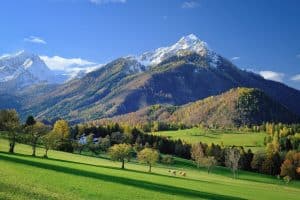Capturing the Beauty of Autumn Landscapes
Key Takeaways
- Discover essential tips for photographing autumn landscapes.
- Learn about the best times and places for capturing fall colors.
- Find out which camera settings will enhance your autumn photos.
- Understand the importance of composition and lighting in landscape photography.
Why Autumn Is Ideal for Landscape Photography

Autumn offers an unparalleled canvas for landscape photography. The season’s vibrant hues and changing foliage create stunning backdrops. Photographers find ample opportunities to capture breathtaking images as the leaves transition from green to a kaleidoscope of reds, oranges, and yellows. The vibrancy of autumn colors can transform even the most familiar scenery into a spectacular visual wonderland.
In addition to its aesthetic appeal, autumn’s mild temperatures and crisp air conditions make photography excursions more comfortable. This is particularly beneficial for extended shoots or visiting destinations prominently highlighted in travel guides. Furthermore, the sun’s angle during the fall months creates longer shadows, adding distinct textures and dimensions to your landscape photos.
Best Times of Day for Capturing Fall Colors
The golden hours of sunrise and sunset provide the most enchanting light for photography. During these times, the warm, soft glow enhances the vividness of fall colors, adding depth and dimension to your shots. Additionally, early mornings can offer the benefit of less crowded locations and a serene atmosphere, which is ideal for capturing uninterrupted shots of nature. Whether you’re exploring local parks or scouting homes for sale in Park City, UT, this period is perfect.
Midday light might present challenges due to its harshness, which can wash out delicate tones. However, it can still work under partly cloudy skies, where the clouds act as a natural diffuser. This helps to diminish harsh shadows and soften the lighting, making for more balanced and pleasing images. Keeping an eye on the weather forecast and being adaptable with your timing can significantly enhance the quality of your photographs, as varying weather conditions can offer unique opportunities for stunning shots.
Top Locations for Autumn Photography
Choosing the right location is crucial for capturing the essence of fall. National parks, forest preserves, and rural areas are often adorned with a rich tapestry of autumn colors. Researching and planning your visit to these top spots can maximize your photographic opportunities.
For instance, iconic locations such as the Great Smoky Mountains, renowned for their biodiversity and vibrant foliage, and Acadia National Park, with its dramatic coastal landscapes, provide abundant picturesque scenes. These well-known destinations offer an array of vibrant scenery during peak foliage. Additionally, local botanical gardens, arboretums, and scenic byways can provide unique perspectives and a variety of subjects to capture. Urban parks and suburban neighborhoods lined with mature trees are also excellent spots to consider for their more curated and accessible beauty.
Essential Camera Settings for Autumn Landscapes
Adjusting your camera settings to match autumn’s ambient light and color saturation can vastly improve your photos. Using a low ISO setting helps reduce noise and ensures clear, sharp images. For crisp, detailed shots, maintaining a narrow aperture (high f-stop) provides a deep depth of field that keeps the entirety of the landscape in focus. Stabilizing your camera with a tripod is particularly useful during longer exposures in low-light conditions to avoid blur.
Another valuable tip is to experiment with your white balance settings to ensure that colors are accurately represented. Adjustments to a cooler or warmer setting can alter the mood of your images, so take the time to find the best balance for your scene. Additionally, techniques such as bracketing can allow you to capture multiple exposures and merge them in post-processing for superior results.
Understanding Composition and Framing
Composition plays a significant role in creating compelling autumn photographs. The Rule of Thirds, layering, and leading lines can guide the viewer’s eye through the image, creating a narrative and enhancing visual interest. Including natural elements like rivers, mountains, and pathways adds structure and context to your photographs, making them more relatable and engaging.
Foreground elements, such as fallen leaves or a winding path, can add depth and invite viewers to explore the scene. Additionally, employing symmetry and asymmetry effectively can evoke different emotions and draw attention to focal points within your image. Experimenting with various angles and perspectives also helps to create unique compositions that stand out.
Maximizing Natural Light
Learning to harness natural light can make your photos stand out. Overcast days might seem dull, but soft, diffused light can reduce harsh shadows and highlight the subtle tones of autumn leaves. Conversely, sunny days with light filtering through the canopy can create dramatic effects with light and shadow, enhancing the texture and vibrancy of your captures.
Utilizing backlighting, where the sun shines through the leaves, can add a magical glow to your photos. This technique highlights the clarity and intricate details of the foliage, creating a mesmerizing effect. Additionally, capturing the interplay of light and shadow can emphasize the three-dimensionality of the landscape, adding depth and interest to your images.
Post-Processing Tips for Autumn Photography
Post-processing can refine and elevate your autumn photos. Adjusting the white balance, enhancing color saturation, and tweaking contrast can bring your images to life. Tools like Adobe Lightroom and Photoshop offer extensive options to optimize your photos, making them share-worthy for any platform. For those looking to delve deeper, numerous tutorials are available to guide you through advanced editing techniques.
Remember, less can often be more when post-processing. Strive for a natural look that enhances features without over-saturating to maintain the authenticity of your autumn shots. Subtle adjustments in sharpness, vibrancy, and clarity can significantly improve the overall quality of your images, making them more visually appealing while preserving the natural charm of the fall season.

